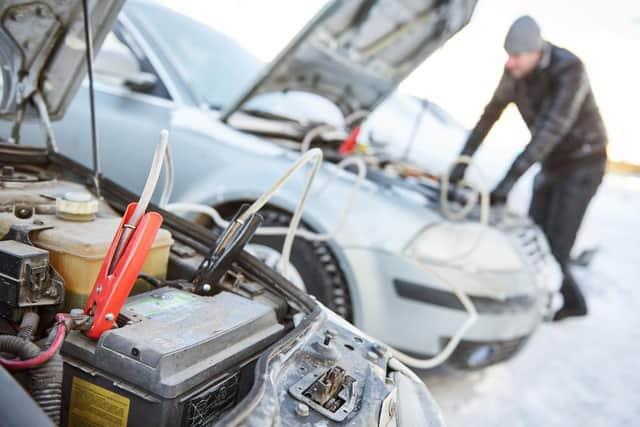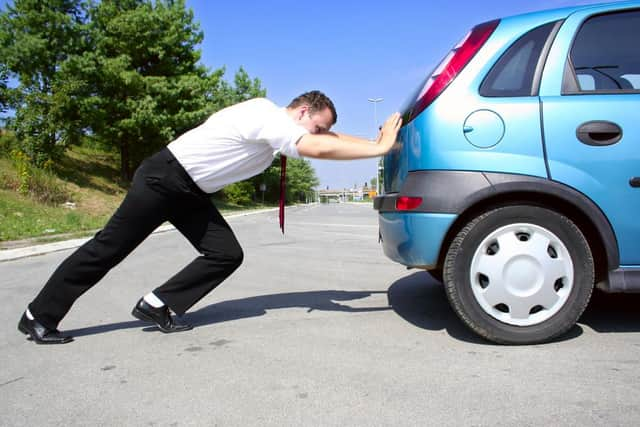How to jump start a car - using jump leads or a push to restore a flat battery
Whether it's due to a car sitting idle for a prolonged period or a bigger underlying issue, batteries can lose their charge, leaving you unable to start your vehicle and potentially ruining your day.
Despite it happening to millions of motorists every year, a poll of drivers by Halfords found that a third don't know how to check their battery while even more don't know what to do if it's flat. Worryingly, 11 per cent don't even know where their car battery is (check your handbook if you're one of them).
Advertisement
Hide AdAdvertisement
Hide AdWith the prospect of problems, knowing how to jump start your car is a useful skill, so here are the simple steps you need to take if you car’s battery has lost its charge.


Using jump leads
For this you’ll need a set of jump leads and a second car with a similar sized engine. Alternatively a battery booster pack works in much the same way.
First check your battery isn’t leaking or damaged. If it is, don’t attempt to jump start it - it’s time to get a replacement.
Make sure all electrical systems such as radios, lights etc are switched off. Position the two cars so their engine bays are close together but the cars aren’t touching. Move any loose metal objects away from both batteries and remove any loose clothing that could get caught and any metal jewellery. Connect one end of the red jump lead to the positive (+) terminal of the working car’s battery, then connect the other end to the positive (+) terminal of the flat battery. Connect one end of the black jump lead to the negative (-) terminal of the working car’s battery and the other end to an earthing point on the other car - this needs to be a solid, paint-free metal point such as a bolt or bracket away from the battery. Start the engine of the working car and allow it to run for a minute or two then try to start the other car. If the battery is very depleted it could take a few attempts. Once the failed car has started leave both cars running for around five minutes before removing the leads. Remove the leads in the reverse order to which you attached them. Make sure they don’t touch any metal surface or get caught in any moving parts. You then need to drive the failed car for 15 minutes or preferably longer in normal conditions (not heavy traffic) to get some charge back into the battery.


If your car won’t start after following these steps you battery has most likely failed completely, in which case you’ll need a new one. And if it won't charge after starting it could be a sign of alternator problems that will need professional attention.
How to jump start a hybrid
With hybrid vehicles featuring more than one battery the process of jump starting them can appear more confusing but it is largely the same. Most hybrids use a large, powerful lithium-ion battery to power their drive functions and a smaller, regular 12V battery to start them and power auxiliary systems such as lights and wipers. In these cases, jump starting the car with jump leads is the same as described above.
However, some cars work slightly differently. Toyota and Lexus hybrids have a dedicated jump start positive terminal, usually located under the fuse box cover. To jump start a Toyota or Lexus hybrid you should connect the positive jump lead to this terminal rather than the battery. Then follow the standard jump starting procedure.
The 2018-onwards Kia Niro hybrid and the related Hyundai Ioniq hybrid don’t have a traditional 12V starter battery. Instead they have a 12V lithium-ion battery which under no circumstances should be jump started. If you find the 12V lithium-ion battery is discharged, it can be reset by pressing the battery reset switch, detailed in the owner’s manual.
Bump starting
Advertisement
Hide AdAdvertisement
Hide AdThis method isn't as safe or reliable as using jump leads so we'd recommend avoiding it unless you're absolutely desperate. It also only works on cars with manual transmission.
For this you'll need a couple of helpers to push the car.
Start by putting the car in second gear and turning the ignition on. Get your helpers to start pushing the car, making sure it's safe to do so. Once the car is moving at at least 5mph let out the clutch quickly. This should engage the transmission and allow the turning of the wheels to get the engine spinning. Once it's running, stop but let the engine run for at least 15 minutes to put some charge back in the battery.
Tips for avoiding a flat battery
The RAC offers the following advice to help protect against a flat battery,:
Park your vehicle in a garage whenever possible to protect it from sharp changes in temperature Ensure everything is switched off when you finish your journey including lights, heater, fan, heated rear windscreen, radio etc. Sat navs and other devices can also drain the battery if left connected – every volt is precious first thing in the morning Check the battery connections, ensuring that they are tight and free from any corrosion. And, don’t forget that battery acid is highly corrosive to skin and paint work It’s worth getting your battery tested, particularly if it is over four years old Take your vehicle for a decent drive to get your battery well charged, and get the engine to its proper operating temperature, before you really need it – ideally several days before. Don’t just check that it starts as this is likely to drain the battery more